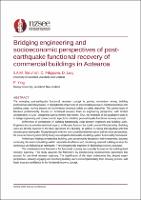| dc.contributor.author | Nkrumah, Sally | |
| dc.contributor.author | Filippova, Olga | |
| dc.contributor.author | Ying, Fei | |
| dc.date.accessioned | 2024-07-01T02:01:24Z | |
| dc.date.available | 2024-07-01T02:01:24Z | |
| dc.date.issued | 2024-04-09 | |
| dc.identifier.uri | https://repo.nzsee.org.nz/xmlui/handle/nzsee/2766 | |
| dc.description.abstract | The emerging post-earthquake functional recovery concept is gaining momentum among building professionals and policymakers. It highlights the importance of incorporating recovery-oriented objectives into building codes, moving beyond the conventional emphasis solely on safety objectives. The current body of literature predominantly focuses on functional recovery from an engineering perspective, with limited consideration of users’ viewpoints such as owners and tenants. Thus, the emphasis of this qualitative study is to bridge engineering and socioeconomic aspects for a holistic post-earthquake functional recovery concept.
Differences in perceptions of building functionality exist between engineers and building users. Engineers tend to prioritise technical aspects, while users focus on the social context of functionality. Building users are directly involved in the daily operations of a building, as well as in coping and adjusting until full recovery post-earthquake. Recognising the inherent interconnection between social and technical perspectives, the socio-technical system (STS) theory was adopted to formulate a building-system functionality framework.
Preliminary findings revealed that building users are primarily focused on their investments, business continuity, the return to buildings within reasonable timeframes and prioritising essential building services for continuous use following an earthquake. These insights help engineers in facilitating recovery processes.
The mobilisation time framework for functional recovery has typically focused on the building-level recovery trajectory. This study advances the framework by incorporating socioeconomic parameters that account for user-level recovery trajectory. The significance of the study underscores that, beyond expert perspectives, actively engaging and involving building users and comprehending their recovery process, will foster trust and confidence in the functional recovery concept. | |
| dc.language.iso | en | |
| dc.publisher | New Zealand Society for Earthquake Engineering | |
| dc.relation.ispartofseries | 2024;176 | |
| dc.subject | Building code compliance, building legislation, standards development, land-use and planning | |
| dc.title | Bridging engineering and social perspectives of post-earthquake functional recovery of commercial buildings | |
| dc.type | Article | |

